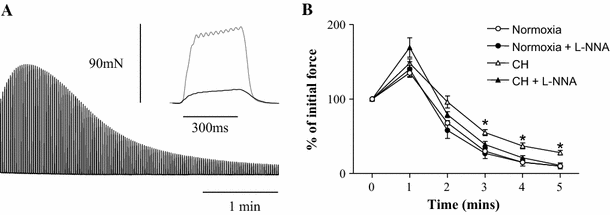Improved tolerance of acute severe hypoxic stress in chronic hypoxic diaphragm is nitric oxide-dependent
- PMID: 26001629
- PMCID: PMC10717054
- DOI: 10.1007/s12576-015-0381-8
Improved tolerance of acute severe hypoxic stress in chronic hypoxic diaphragm is nitric oxide-dependent
Abstract
The effects of chronic hypoxia (CH) on respiratory muscle performance have hardly been investigated, despite clinical relevance. Results from recent studies are indicative of unique adaptive strategies in hypoxic diaphragm. Respiratory muscle tolerance of acute severe hypoxic stress was examined in normoxic and CH diaphragm in the presence and absence of a nitric oxide (NO) synthase inhibitor. We tested the hypothesis that improved tolerance of severe hypoxic stress in CH diaphragm is NO-dependent. Wistar rats were exposed to normoxia (sea-level, n = 6) or CH (ambient pressure = 380 mmHg, n = 6) for 6 weeks. Diaphragm muscle functional properties were determined ex vivo under severe hypoxic conditions (gassed with 95%N2/5% CO2) with and without 1 mM L-N(G)-nitroarginine (L-NNA, nNOS inhibitor). Fatigue tolerance, but not force, was significantly improved in CH diaphragm (p = 0.008). CH exposure did not affect diaphragm muscle fibre oxidative capacity determined from cluster analysis of area-density plots of muscle fibre succinate dehydrogenase activity. Acute NOS inhibition reduced diaphragm peak tetanic force (p = 0.018), irrespective of gas treatment, and completely reversed improved fatigue tolerance of the CH diaphragm. We conclude that CH exposure improves fatigue tolerance during acute severe hypoxic stress in an NO-dependent manner, independent of muscle fibre oxidative capacity.
Conflict of interest statement
None of the authors has any conflict of interest to report.
Figures



Similar articles
-
Diaphragm plasticity in aging and disease: therapies for muscle weakness go from strength to strength.J Appl Physiol (1985). 2018 Aug 1;125(2):243-253. doi: 10.1152/japplphysiol.01059.2017. Epub 2018 Apr 19. J Appl Physiol (1985). 2018. PMID: 29672230 Free PMC article. Review.
-
Chronic hypoxia increases rat diaphragm muscle endurance and sodium-potassium ATPase pump content.Eur Respir J. 2011 Jun;37(6):1474-81. doi: 10.1183/09031936.00079810. Epub 2010 Dec 9. Eur Respir J. 2011. PMID: 21148231
-
Nitric oxide modulates neuromuscular transmission during hypoxia in rat diaphragm.Muscle Nerve. 2006 Jan;33(1):104-12. doi: 10.1002/mus.20445. Muscle Nerve. 2006. PMID: 16247767
-
Reactive oxygen species mediated diaphragm fatigue in a rat model of chronic intermittent hypoxia.Exp Physiol. 2014 Apr;99(4):688-700. doi: 10.1113/expphysiol.2013.076828. Epub 2014 Jan 17. Exp Physiol. 2014. PMID: 24443349
-
Redox Remodeling Is Pivotal in Murine Diaphragm Muscle Adaptation to Chronic Sustained Hypoxia.Am J Respir Cell Mol Biol. 2016 Jul;55(1):12-23. doi: 10.1165/rcmb.2015-0272OC. Am J Respir Cell Mol Biol. 2016. PMID: 26681636
Cited by
-
Respiratory muscle dysfunction in animal models of hypoxic disease: antioxidant therapy goes from strength to strength.Hypoxia (Auckl). 2017 Jul 14;5:75-84. doi: 10.2147/HP.S141283. eCollection 2017. Hypoxia (Auckl). 2017. PMID: 28770235 Free PMC article. Review.
-
Effects of temperature on the locomotor performance and contraction properties of skeletal muscle from two Phrynocephalus lizards at high and low altitude.J Comp Physiol B. 2021 Sep;191(5):907-916. doi: 10.1007/s00360-021-01391-9. Epub 2021 Aug 3. J Comp Physiol B. 2021. PMID: 34341847 Review.
-
Diaphragm plasticity in aging and disease: therapies for muscle weakness go from strength to strength.J Appl Physiol (1985). 2018 Aug 1;125(2):243-253. doi: 10.1152/japplphysiol.01059.2017. Epub 2018 Apr 19. J Appl Physiol (1985). 2018. PMID: 29672230 Free PMC article. Review.
-
Treadmill walking in water induces greater respiratory muscle fatigue than treadmill walking on land in healthy young men.J Physiol Sci. 2016 May;66(3):257-64. doi: 10.1007/s12576-015-0423-2. Epub 2015 Nov 18. J Physiol Sci. 2016. PMID: 26582640 Free PMC article. Clinical Trial.
-
Diaphragm Muscle Weakness Following Acute Sustained Hypoxic Stress in the Mouse Is Prevented by Pretreatment with N-Acetyl Cysteine.Oxid Med Cell Longev. 2018 Feb 19;2018:4805493. doi: 10.1155/2018/4805493. eCollection 2018. Oxid Med Cell Longev. 2018. PMID: 29670681 Free PMC article.
References
Publication types
MeSH terms
Substances
LinkOut - more resources
Full Text Sources

